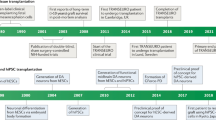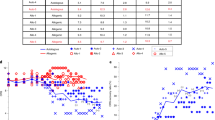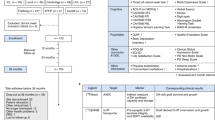Abstract
Postmortem analysis of five subjects with Parkinson's disease 9–14 years after transplantation of fetal midbrain cell suspensions revealed surviving grafts that included dopamine and serotonin neurons without pathology. These findings are important for the understanding of the etiopathogenesis of midbrain dopamine neuron degeneration and future use of cell replacement therapies.
This is a preview of subscription content, access via your institution
Access options
Subscribe to this journal
Receive 12 print issues and online access
$209.00 per year
only $17.42 per issue
Buy this article
- Purchase on Springer Link
- Instant access to full article PDF
Prices may be subject to local taxes which are calculated during checkout


Similar content being viewed by others
References
Isacson, O., Bjorklund, L.M. & Schumacher, J.M. Ann. Neurol. 53 Suppl 3, S135–S148 (2003).
Lewy, F. Dtsch. Z. Nervenheilkd. 50, 50–55 (1913).
Eriksen, J.L., Wszolek, Z. & Petrucelli, L. Arch. Neurol. 62, 353–357 (2005).
Takahashi, H. & Wakabayashi, K. Neuropathology 21, 315–322 (2001).
Mendez, I. et al. Brain 128, 1498–1510 (2005).
Baba, M. et al. Am. J. Pathol. 152, 879–884 (1998).
Kuusisto, E., Parkkinen, L. & Alafuzoff, I. J. Neuropathol. Exp. Neurol. 62, 1241–1253 (2003).
Galvin, J.E., Schuck, T.M., Lee, V.M. & Trojanowski, J.Q. Exp. Neurol. 168, 347–355 (2001).
Carlsson, T., Carta, M., Winkler, C., Bjorklund, A. & Kirik, D. J. Neurosci. 27, 8011–8022 (2007).
Carta, M., Carlsson, T., Kirik, D. & Bjorklund, A. Brain 130, 1819–1833 (2007).
Pruszak, J., Sonntag, K.C., Aung, M.H., Sanchez-Pernaute, R. & Isacson, O. Stem Cells 25, 2257–2268 (2007).
Freed, C.R. et al. N. Engl. J. Med. 344, 710–719 (2001).
Olanow, C.W. et al. Ann. Neurol. 54, 403–414 (2003).
Perrier, A.L. et al. Proc. Natl. Acad. Sci. USA 101, 12543–12548 (2004).
Roy, N.S. et al. Nat. Med. 12, 1259–1268 (2006).
Acknowledgements
This work was supported by the Canadian Institute of Health Research, Queen Elizabeth II Health Sciences Centre (I.M.), US National Institutes of Health NINDS Parkinson's Disease Research Center of Excellence (P50 NS 39793 to O.I. and NS 053488 to J.Q.T.), The Michael Stern Foundation (O.I.), The Consolidated Anti-Aging Foundation (O.I.), The Orchard Foundation (O.I.) and the Harold and Ronna Cooper Family (O.I.). Fellowship support to K.M. was provided by the Dalhousie Medical Research Foundation and Parkinson Society Canada. We also thank O. Cooper for evaluation of tissue sections from study subjects.
Author information
Authors and Affiliations
Contributions
I.M. and A.V. designed research, performed research, analyzed data and wrote the paper. A.A. and P.H. performed research, analyzed data and wrote the paper. K.M. analyzed data and wrote the paper. H.R., T.T., R.H. and A.D. performed research and analyzed data. J.Q.T. performed neuropathology staining, analyzed raw data, evaluated and interpreted data and wrote the paper. O.I. designed research, performed research, analyzed raw data, evaluated and interpreted data and wrote the paper.
Corresponding author
Supplementary information
Supplementary Text and Figures
Supplementary Tables 1 and 2, Supplementary Fig. 1, Supplementary Methods and Supplementary Results (PDF 387 kb)
Rights and permissions
About this article
Cite this article
Mendez, I., Viñuela, A., Astradsson, A. et al. Dopamine neurons implanted into people with Parkinson's disease survive without pathology for 14 years. Nat Med 14, 507–509 (2008). https://doi.org/10.1038/nm1752
Received:
Accepted:
Published:
Issue Date:
DOI: https://doi.org/10.1038/nm1752
This article is cited by
-
Research progress of neural stem cells as a source of dopaminergic neurons for cell therapy in Parkinson’s disease
Molecular Biology Reports (2024)
-
Cell-therapy for Parkinson’s disease: a systematic review and meta-analysis
Journal of Translational Medicine (2023)
-
Mesenchymal stromal cell biotherapy for Parkinson’s disease premotor symptoms
Chinese Neurosurgical Journal (2023)
-
Discrepancy between distribution of alpha-synuclein oligomers and Lewy-related pathology in Parkinson’s disease
Acta Neuropathologica Communications (2022)
-
Persistent dyskinesias in patients with fetal tissue transplantation for Parkinson disease
npj Parkinson's Disease (2021)



